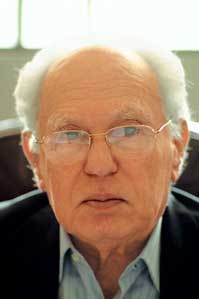
MIGUEL BOYAYANGoldemberg: first person to show it was feasible to use sugarcane to produce ethanolMIGUEL BOYAYAN
In an article published in the September 8, 1978 edition of the journal Science, the physicist José Goldemberg, who at the time was with the School of Physics at the University of São Paulo (IF/USP), calculated the amount of energy that three different plants (manioc, sweet sorghum and sugarcane) consumed to produce ethanol. “Sugarcane is the most efficient in producing ethyl alcohol, followed by sorghum and then manioc from an energy perspective”, wrote the Brazilian researcher in his article’s abstract. In his study, Goldemberg also noted that 60% to 75% of the energy needed to obtain ethanol from plants is consumed during the industrial phase of the process; the agricultural phase consumes less energy. Almost 30 years later, with a competitive price and environmental appeal, sugarcane ethanol is used in most of the Brazil’s flex-fuel cars and is now regarded among developed countries as a type of biofuel capable of reducing the world’s dependence on oil and lowering global warming a little. It seems that Goldemberg’s calculations were accurate.
Time magazine recently published an article recollecting the Brazilian physicist’s groundbreaking study on what was only a candidate for biofuel at the time. “Today, when American farmers enjoy the benefits of subsidized ethanol, it’s easy to forget that the idea of fuelling the economy through a plant, rather than oil, was once a marginal notion. But José Goldemberg remembers”, stated the magazine. On account of his article published in 1978 in Science, Time named the Brazilian physicist one of its ‘environmental heroes’ in a special edition published in October. “Today, Brazil is a leader in biofuels”, acknowledges the magazine, noting that ethanol has accounted for a 20% reduction in Brazil’s carbon emissions.
Together with key international political figures, such as former Soviet leader Mikhail Gorbachev (who founded Green Cross International), former US vice-president Al Gore (who, for his environmental activism, shared the 2007 Nobel Peace Prize with scientists from the Intergovernmental Panel on Climate Change), and Germany’s current Chancellor, Angela Merkel, Goldemberg was identified as one of the “environmental heroes” in the Leaders & Visionaries category. The 79 year-old physicist, former state minister and former president of the University of São Paulo (among other positions he held during the course of his career) continues to work at USP’s Electronic Engineering and Energy Institute. “I was taken by surprise with Time’s tribute and for including me in this category”, stated Goldemberg, who chairs the São Paulo State Bioenergy Committee. “Other people have contributed to the development of ethanol production in Brazil.”
Sustainability recognized
Toward the end of the year, Time generally publishes a special edition to honor the “heroes of the year”: famous or unknown people in various lines of work, who, according to the magazine, have influenced humanity in the preceding twelve months. In 2007, the year when global warming was definitively included in many countries’ political agenda as result of the alarming statistics announced by the IPCC, the magazine changed the criteria for choosing the key personalities of the moment and decided to focus on the Earth’s sustainability. In 2007, Time highlighted 43 ‘environmental heroes’ in four different categories: Leaders & Visionaries, Activists, Scientists & Innovators and Magnates & Entrepreneurs. The selected group of personalities are individuals with different profiles and from different fields of work, who, according to the magazine”, are speakers for the planet, a planet that is unbalanced. Goldemberg is the only Brazilian on the list.
The physicist recalls the environment back at the time when Brazil’s ethanol studies began, more than three decades ago. After the 1973 oil crisis, the Brazilian government started to look for alternatives to cut its heavy dependence on imported fuel. Sugarcane ethanol and the government-funded Pro-alcohol program were products of this initiative. One of the highlights of Goldemberg’s article revealed the low amount of fossil fuel used as fertilizer to grow sugarcane, in the production of sugarcane-based ethanol. In other words, not only is it possible, but also economically feasible (and good for the environment) to use sugarcane ethanol as a source of energy. Currently, one of the greatest problems with corn-based ethanol, as produced in the US, is the high amount of fossil fuel used in the process. “We need to continue investing to maintain our leadership in the sector”, stated Goldemberg, who has always been against the building of nuclear plants in the town of Angra dos Reis, in the state of Rio de Janeiro.
Republish